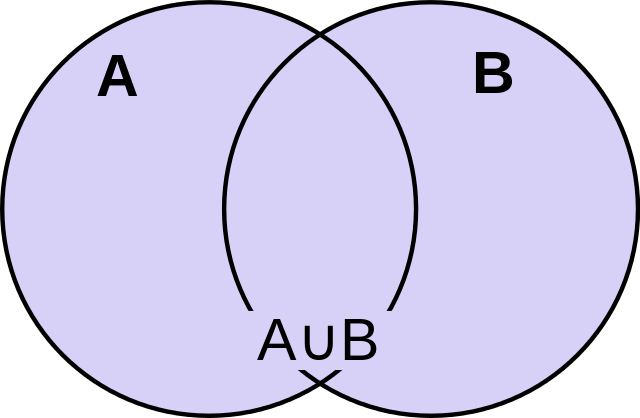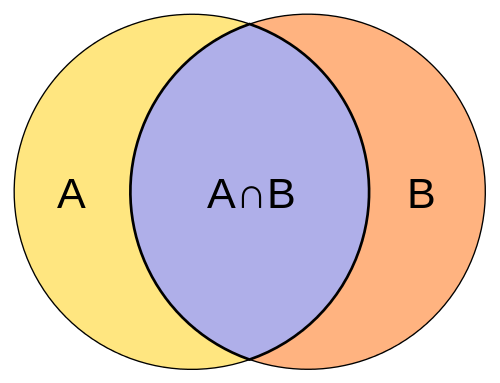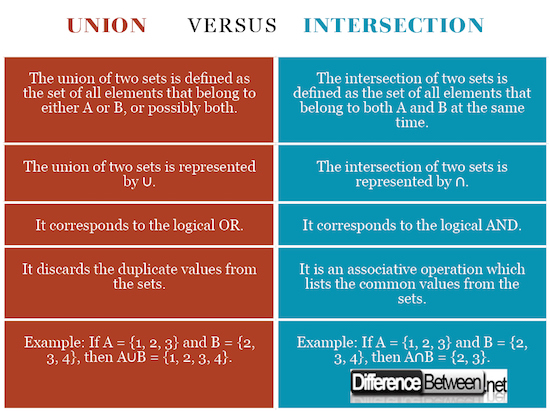Difference Between Union and Intersection
Before understanding the difference between the two set operators union and intersection, let’s understand the concept of set theory first. Set theory is a fundamental branch of mathematics that studies sets, particularly whether an object belongs, or does not belong to, a set of objects that are somehow relevant mathematics. Set is basically a collection of well-defined objects, which may or may not be of mathematical relevance, such as numbers or functions. The objects in a set are called elements, which can be anything like numbers, people, cars, states, etc. Almost anything and any number of elements can be collected together to create a set.
In simple terms, set is a collection of any number of unordered elements that can be regarded as a single object as a whole. Let’s understand the basic concepts and notation of a set and how it is represented. It all begins with a binary relation between an object x and a set A. To represent if x is a member of a set A, the notation x ∊ A is used, while x ∉ A indicates that the object x does not belong to the set A. The member of a set are listed within curly braces. For example, the set of prime numbers less than 10 can be written as {2, 3, 5, 7}. Similarly, a set of even numbers less than 10 can be written as {2, 4, 6, 8}. Hypothetically, almost any finite set can be represented by its members.

What is Union of Sets?
The union of two sets A and B is defined as the set of elements that belong to either A or B, or possibly both. It is simply defined as the set of all distinct elements or members, where the members belong to any of these sets. The union operator corresponds to the logical OR and is represented by the symbol ∪. It is the smallest set containing all the elements of both the sets. For example, if set A is {1, 2, 3, 4, 5} and set B is {3, 4, 6, 7, 9}, then the union of A and B is represented by A∪B and is written as {1, 2, 3, 4, 5, 6, 7, 9}. As the numbers 3 and 4 are present in both the sets A and B, there is no need to list them twice. It is evident that the number of elements of the union of A and B is smaller than the sum of the individual sets, because few numbers are common in both the sets.
A = {1, 3, 5, 7, 9}
B = {3, 6, 9, 12, 15}
A∪B = {1, 3, 5, 6, 7, 9, 12, 15}
What is Intersection of Sets?
The intersection of two sets A and B is defined as the set of elements that belong to both A and B. It is simply defined as the set containing all elements of the set A that also belong to the set B, and similarly all elements of set B belong to the set A. The intersection operator corresponds to the logical AND and is represented by the symbol ∩. On the contrary, the intersection of two sets is the largest set containing all the elements common to both the sets. For example, if set A is {1, 2, 3, 4, 5} and set B is {3, 4, 6, 7, 9}, then the intersection of A and B is represented by A∩B and is written as {3, 4}. As only the numbers 3 and 4 are common in both sets A and B, they are called the intersection of the sets.
A = {2, 3, 5, 7, 11}
B = {1, 3, 5, 7, 9, 11}
A∩B = {3, 5, 7, 11}

Difference between Union and Intersection of Sets
- Basic – The union of two sets A and B is defined as the set of elements that belong to either A or B, or possibly both, whereas the intersection of two sets is defined as the set of elements that belong to both A and B.
- Symbolic Representation – The union of two sets is represented by the symbol “∪”, whereas the intersection of two sets is represented by the symbol “∩”.
- Logical Relevance – The union of two sets corresponds to the logical “OR” whereas the intersection of two sets correspond to the logical “AND”.
- Example – Let A = {a, e, i, o, u} and
B = {a, b, c, d, e, f}
A∪B = {a, b, c, d, e, f, i, o, u}
A∩B = {a, e}
Union vs. Intersection: Comparison Chart

Summary of Union vs. Intersection
Both union and intersection are the two fundamental operations through which sets can be combined and related to each other. In terms of set theory, union is the set of all the elements that are in either set, or in both, whereas intersection is the set of all distinct elements that belong to both the sets. The union of two sets A and B is symbolized as “A∪B”, whereas intersection of A and B is symbolized as “A∩B”. Set is nothing but a collection of well-defined objects, such as numbers and functions, and the objects in a set are called as elements.
- Difference Between Serif and Sans Serif - April 22, 2024
- Difference Between HTML and Text - April 19, 2024
- Difference Between FTP and SFTP - April 16, 2024
Search DifferenceBetween.net :
 Email This Post
: If you like this article or our site. Please spread the word. Share it with your friends/family.
Email This Post
: If you like this article or our site. Please spread the word. Share it with your friends/family.
1 Comment
Leave a Response
References :
[0]Halmos, Paul R. Native Set Theory. Berlin: Springer, 1998. Print
[1]Kunen, Kenneth. Set Theory: An introduction to Independence Proofs. Amsterdam: North-Holland Publishing, 1983. Print
[2]Hummel, Kenneth E. Introductory Concepts for Abstract Mathematics. Boca Raton: CRC Press, 2000. Print
[3]Image credit: https://upload.wikimedia.org/wikipedia/commons/thumb/9/99/Venn_diagram_for_A_union_B.svg/640px-Venn_diagram_for_A_union_B.svg.png
[4]Image credit: https://upload.wikimedia.org/wikipedia/commons/thumb/1/1f/Intersection_of_sets_A_and_B.svg/500px-Intersection_of_sets_A_and_B.svg.png


I am looking for a sign that may represent a planet(P2) placed in a house (H4)in astrology. Since I can use neither Union Sign nor the Intersection Sign, kindly tell me which Sign of the Set Theory I may use.